To view this content, you must be a member of the Rose City Review Patreon
Already a qualifying Patreon member? Refresh to access this content.
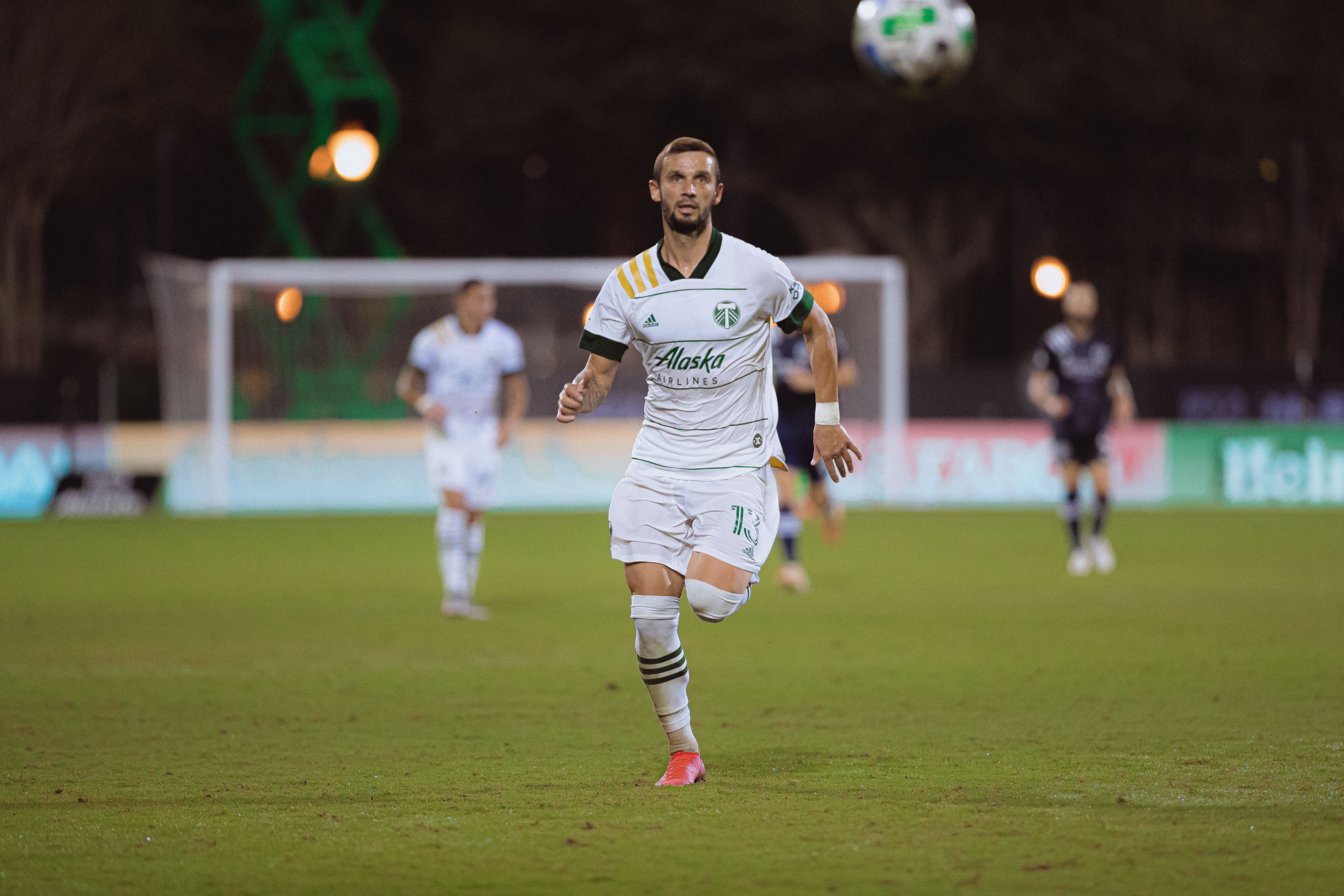
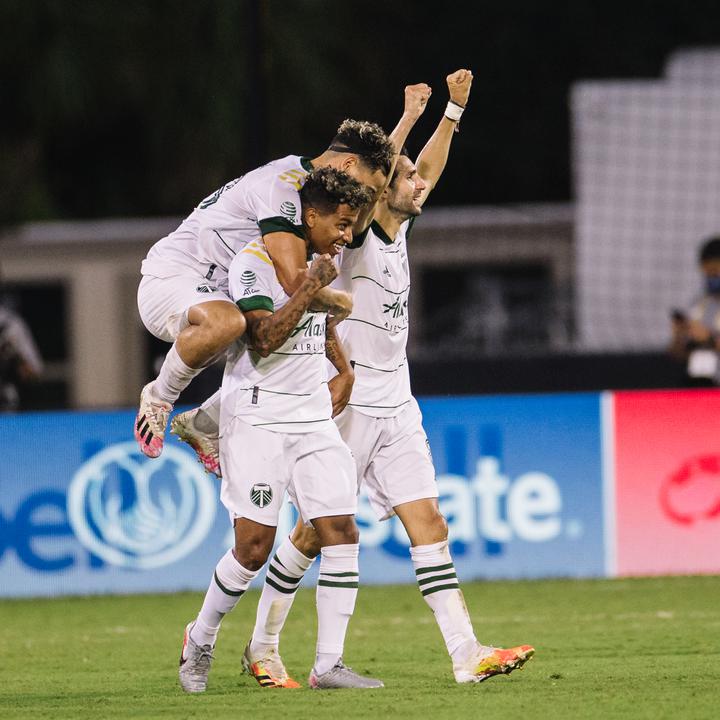
After a narrow escape against FC Cincinnati on Tuesday, the Portland Timbers looked set for another nail-biting match in the MLS is Back Tournament quarterfinals after going down 1-0 early.
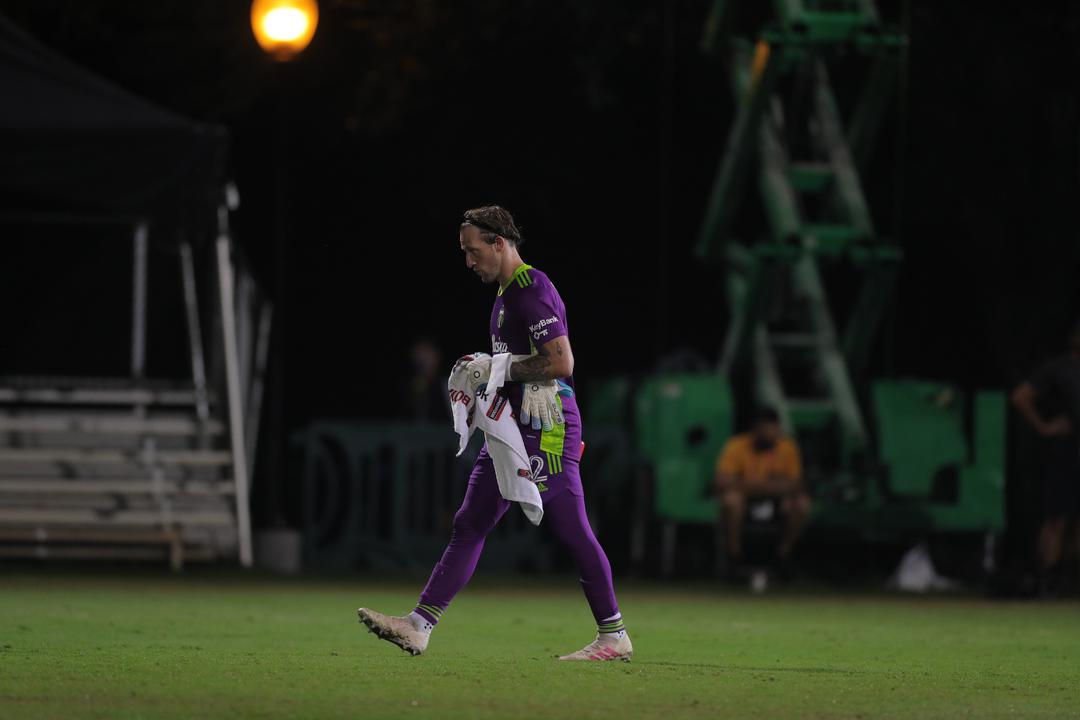
It looked like the Timbers were well on their way to a 1-0 win over a bunkered in FC Cincinnati side Tuesday evening when, out of nowhere, goalkeeper Steve Clark made things interesting…
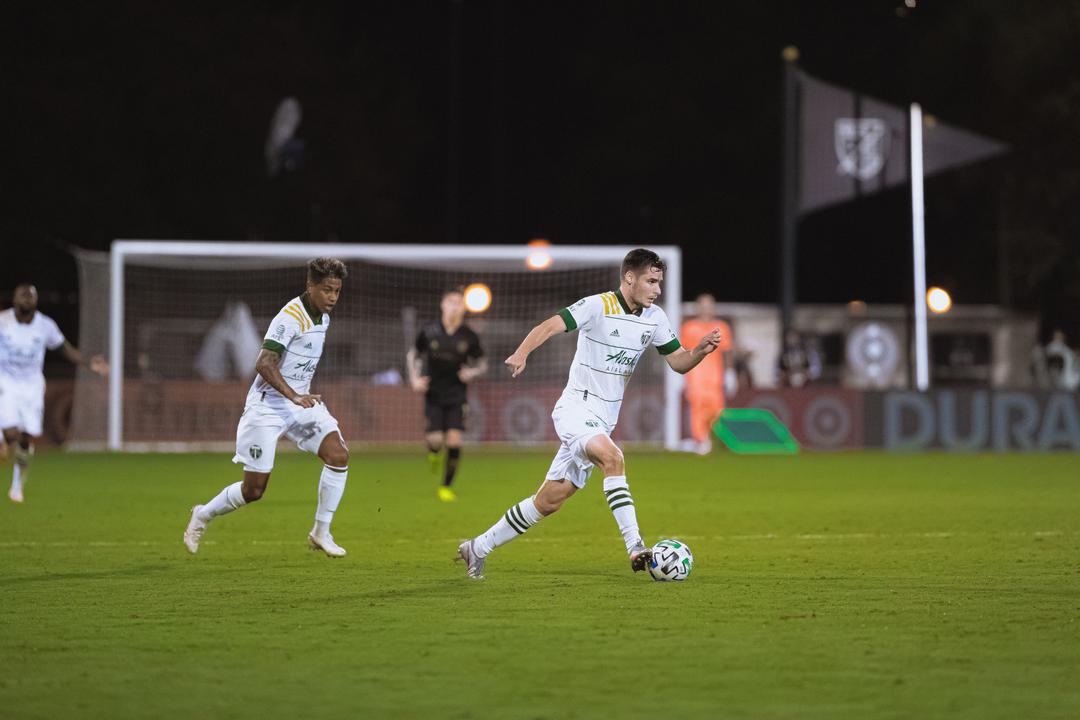
Match after match, the Portland Timbers continue to impress.
Two games in, and it seems as if there’s something new and more creative to take away from each game—something that we did not see back in March.
Against the Los Angeles Galaxy, we saw an increased sense of confidence throughout the team that manifested itself through the team’s combination play and intricate movement. In its game against Houston, we saw a team both creating and exploiting space all around the field, playing long balls with a purpose to unlock the Dynamo defense while shutting down one of Major League Soccer’s most potent attacks.
Portland did it again on Thursday night, coming in with a disciplined and compact defensive shape that managed to contain what is usually a LAFC buzzsaw to win Group F.
I don’t have much to say to open this column other than just to mention how impressive this Portland team has been over three games. The shape that the Timbers played last night required a lot of discipline (which I will go into later). I mentioned on Twitter than containing LAFC for 90 minutes is a Herculean effort––both the Dynamo and Galaxy learned that over the past week––and Portland looked defensively solid for more than 75 percent of the game. I guess what I am saying is that the Timbers look primed to make a run in this tournament and that my outlook on the team is a lot brighter than what it was when I left Providence Park back in March.
And … I guess I should mention that I had to put my bonfire-building supplies away late into the match. It’s time for the Timbers to get revenge for what was an embarrassing defeat a season ago.
The Timbers got out to a dream start against LAFC, striking first in the seventh minute.
Taking advantage of LAFC’s aggression, Portland found success in testing the opposing backline early and often. Thanks to ESPN’s aerial cam, it’s easy to see what went into Niezgoda’s opening goal, the Pole’s first as a Timber.
During this transitional moment, Portland creates a mini-overload on the right side of the field. During this, Niezgoda is sitting between the right center back and right back, waiting to pounce. The overload pulls Tristan Blackmon towards the sideline while Latif Blessing, the right back, is caught cheating a little too far up the field. This leaves Niezgoda with yards of space to run into, and he makes the finish look easy.
Conceding first is not a new trend for Bob Bradley’s men: They did it against both the Houston Dynamo and LA Galaxy. This may be looked back upon as an easy finish, but the goal proved vital for the Timbers, allowing them to weather 15 minutes of LAFC brilliance and come away with a point at the end of the game.
Yes, Bradley Wright-Phillips is not the same lethal player that carried the New York Red Bulls on his shoulders for what seems like a decade, but he is still one of the most dangerous strikers in MLS—and he proved it yet again on Thursday night.
This goal comes down to movement. Wright-Phillips sees the right side of defense pushed high and immediately makes a looping run to find that space while losing his defender, Bill Tuiloma, in the process.
Thanks to the space that his movement created, when Wright-Phillips receives the ball, he has a few touches to settle it before firing it past Clark. This is a clinical, outside-the-box finish from the Englishman, proving that age is just a number.
In his post-game media availability, head coach, Giovanni Savarese, mentioned the tired legs that his team was playing with near the end of the first half. That can easily be seen in the second goal the Timbers gave up in the course of four minutes.
Honestly, there is not too much to this goal. It’s just poor marking at the back post by Bill Tuiloma as Kaye gets by him with a quick spin move. Kudos to the Canadian for the good finish, because there’s nothing that Clark could really do there.
In a tournament with so many young players breaking out for their respective teams, Jeremy Ebobisse’s star may shine among the brightest.
For the third-consecutive game, Ebobisse found the back of the net for Portland, this time rising up and sending a towering header past Sisniega.
This is just pure grit from some of the Timbers tallest players. In a way, Tuiloma makes up for his role in the two LAFC goals as he finds the energy to rise up and win this ball in a crowded box. After a missed half-chance minutes earlier, Ebobisse makes no mistake this time as he powered the ball to the bottom right corner.
Ebobisse is making a name for himself so far this tournament. You have to think that US Men’s National Team coach, Gregg Berhalter, is watching every game in the bubble with a close eye and Ebobisse is commanding his attention.
One of my biggest takeaways from this match is the defense shape that the Timbers played in. It was a narrow 4-4-2, both horizontally and vertically, that allowed space out wide, but prevented any penetration from a LAFC lineup that knows how to exploit even a sliver of space. Playing with such a compact shape for 90 minutes against one of the league’s best sides requires insane amounts of focus and discipline. Give or take a few moments, the Timbers looked relatively drilled in this setup.
The 4-4-2 did its job for a majority of the game. As seen above, LAFC was content to pass it backwards and around the block. To exploit this system, the ball needs to be played quickly between the lines with a purpose. Because LAFC played more of a probing style early on in the game, players were able to step up and win balls in both defense and midfield. According to Opta, the Timbers made 40 CLEARANCES(!!!) over the course of the game compared to LAFC’s eight.
Below, I’m going to insert a couple of examples of what the Timbers want to do. It’s a lot of last-ditch tackling that happened time and time again throughout the game.
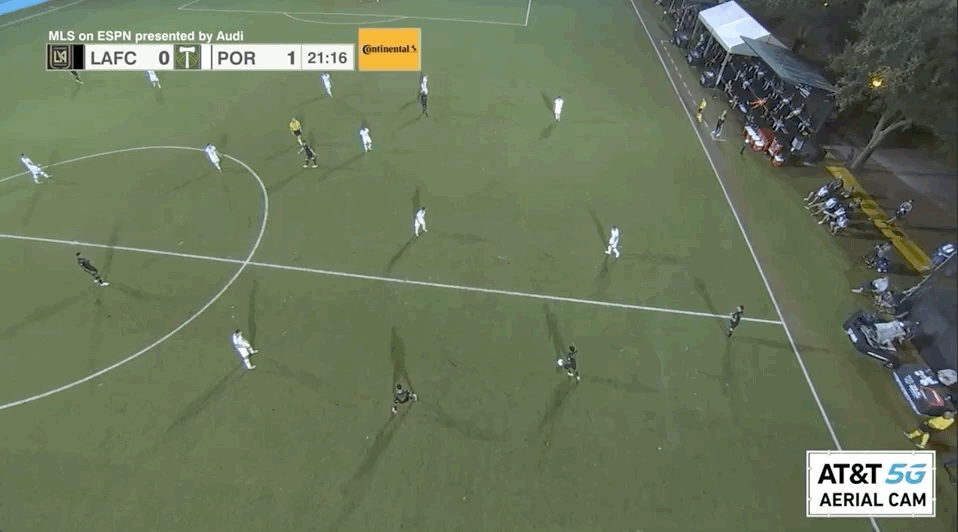
In this clip, the midfield does a good job of stepping up and preventing LAFC to get the ball in a dangerous, central area.
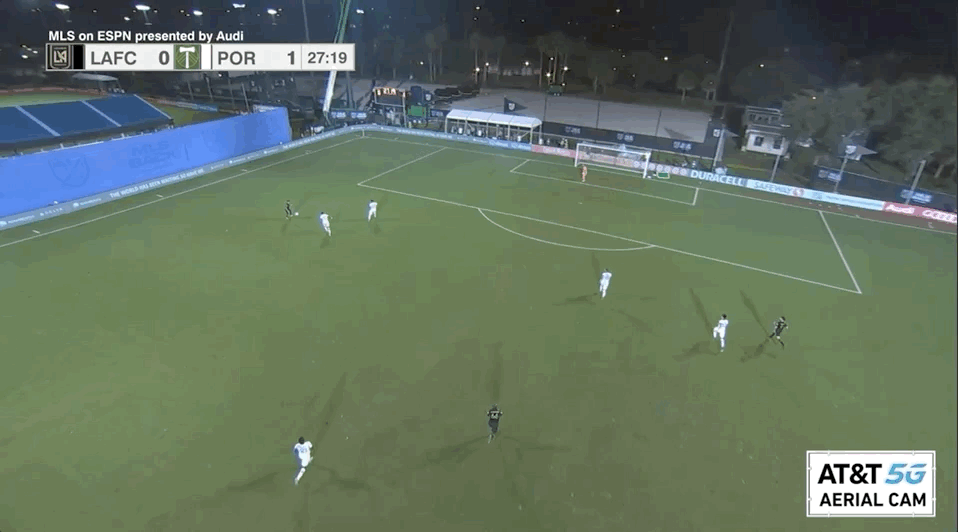
Here, the defense does a great job to cut this pass off as LAFC looks to make a direct pass towards the top of the box.
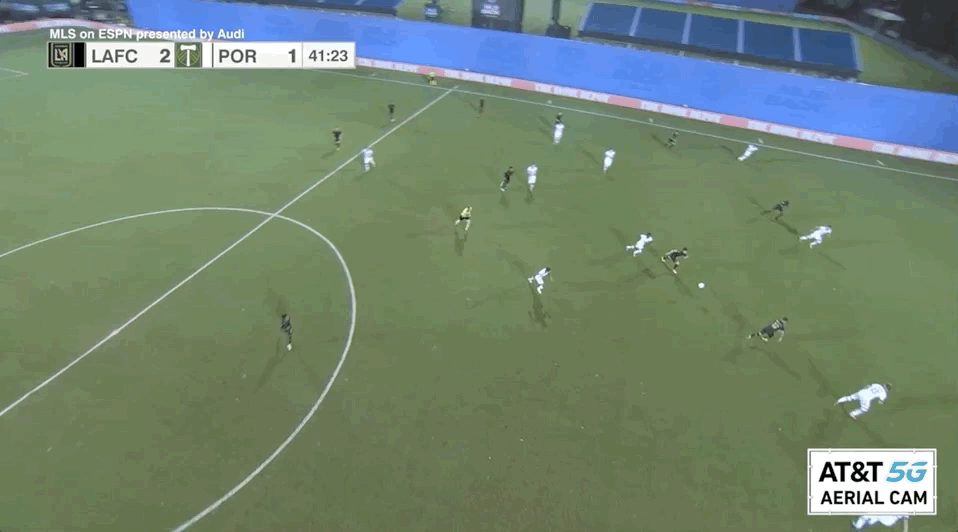
This third example is what happens when you have a defensive midfield of Diego Chará and Cristhian Paredes. Portland wanted to ensure that if LAFC tried to play centrally, they would be punished. And it worked.
There’s so much that I wanted to touch on when it comes to the defense side of the ball that I thought I should separate it into two different sections.
The defensive shape that Portland used was a very compact 4-4-2. How it defended was in a mid-block.
By playing this way, the Timbers invited LAFC to towards midfield before applying pressure. The goal of this is to create space in behind LAFC’s backline, and then take advantage of the aggression to create opportunities by running into this now-vacated area.
The Timbers were relatively successful early on but, from the 30th minute until halftime, players started to get tired, and they stopped playing into the space that they created after winning the ball. This allowed LAFC to implement a counter man-marking system, which continued to win the ball high up the field, effectively trapping Portland in its own half.
“I think what was difficult today was when we lost the ball so quickly,” Diego Chará said after the game. “When we recovered the ball, we tried to play forward, but we missed a lot of passes, and I think that made it more difficult for us to keep the ball.”
All of this is evident in the graphics below.
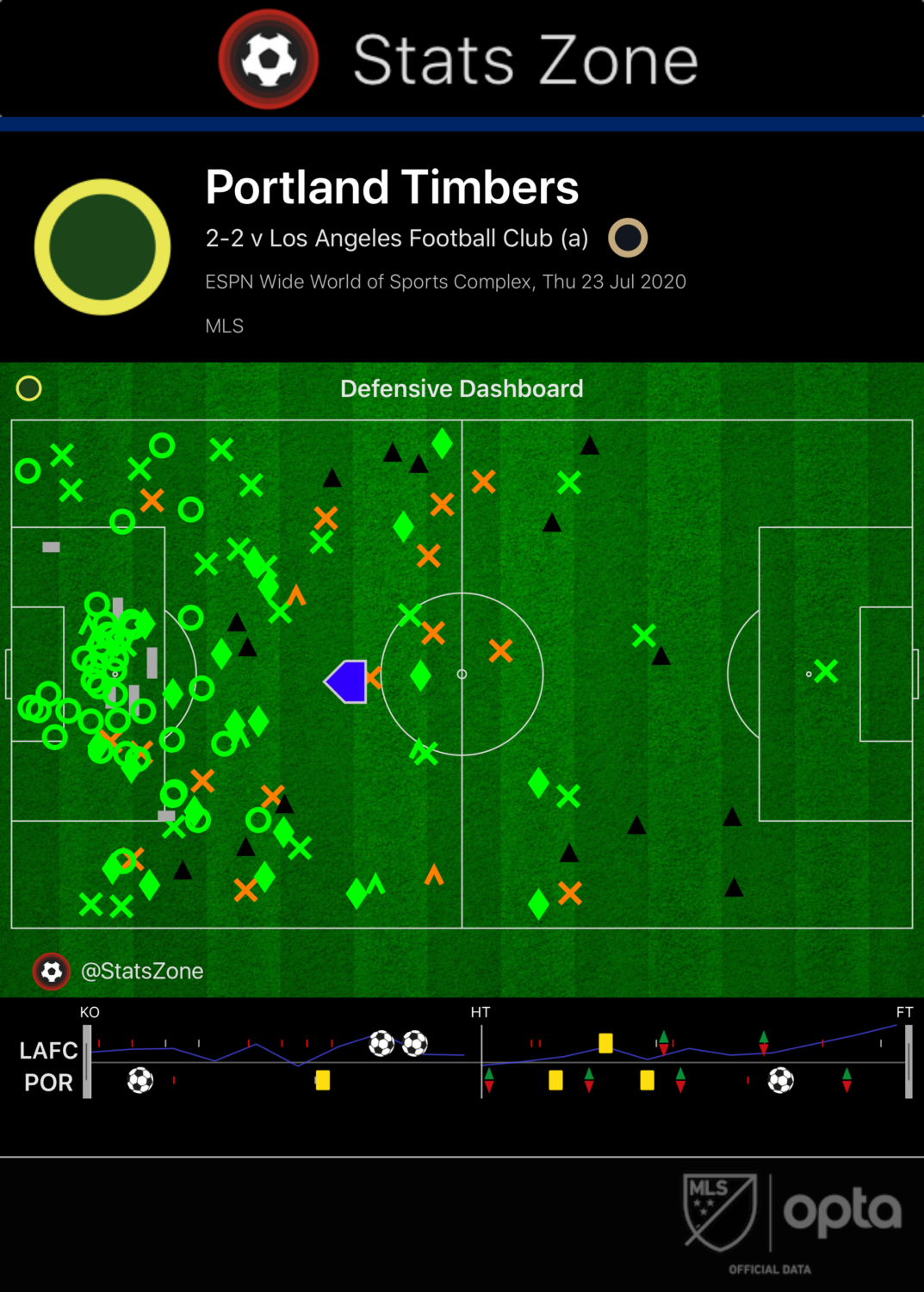
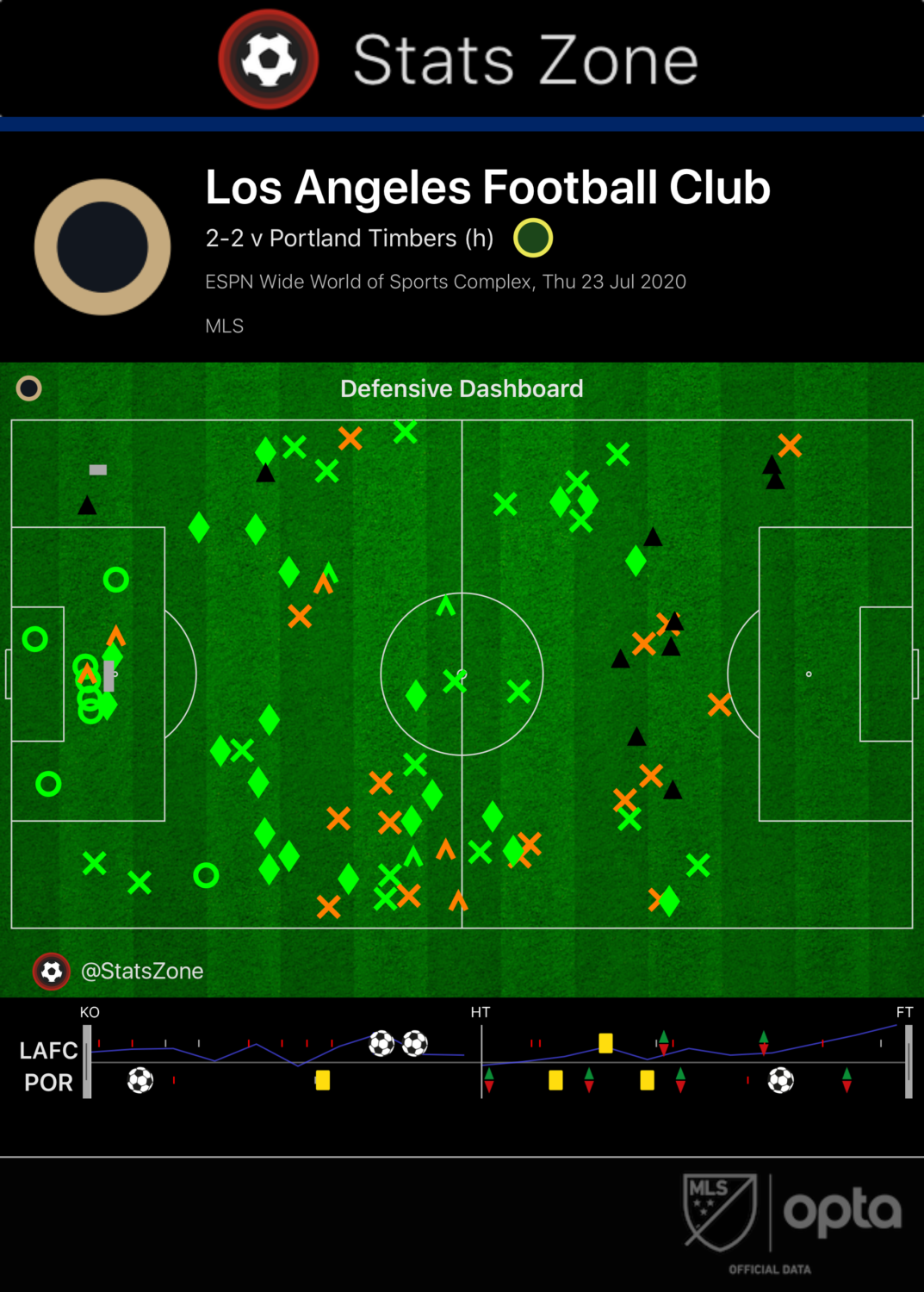
Look at where Portland defends versus where LAFC defends. Portland is playing a dangerous game of bend-but-don’t-break soccer, mostly in its own half, while LAFC is constantly trying to play on the front foot.
I can throw so many more graphics and stats such as the ones above in the article, but I don’t need to. The Timbers put on a defensive masterclass on Thursday night. Sure, it wasn’t perfect, but it’s the type of shape that every team that wants to make a deep run into a tournament needs. It’s important to remember that LAFC can exploit any defensive system and, if the Timbers could look like this defensively every game, they could go quite far in Orlando.
“The first thirty minutes we had the better of the play. We were very tight, and we didn’t allow them to be able to create much,” Savarese said when asked about LAFC’s dominant stretch. “In the last 15 minutes in the first half, they started to find the balls in between the lines; they started making better movements in those areas that we wanted to protect, and we were tired so we couldn’t close those spaces as well as we did the first thirty minutes.
“We also gave up the ball in those moments, different than the first thirty minutes when we had a lot of the ball and were smart in the way me moved it. I think that the two goals were two moments that are a little bit separated from them finding space. Yes, they had a little bit more of the ball in those minutes, they tried to create, but we defended very very well even though we had some players being tired.”
When a team presses as hard as LAFC does, the opponent usually has two options: A) Try to play through the pressure in hopes to find space to attack into; or B) Stop thinking for a few seconds and clear the ball, praying to find a teammate somewhere in the attack.
In the past, the Timbers would have taken option B, trying to recycle the ball wide and play it long, which often resulted in a quick loss of possession. But these are not the Timbers of old. Against LAFC, Portland invited the pressure and attempted to move up the field through multiple series of intricate passing and combination play. It did not always work, but when it did it was pretty.
Part of playing through a press is knowing when to commit numbers forward after winning the ball versus when to sit back. Whatever the decision is, every player needs to be on the same page to ensure that there are no gaps. Playing into the created space catches a team when they are most vulnerable at the back, but if you lose the ball, there is now plenty of vacated space for the opposing team to exploit.
Above is an example of what happens when a team gambles wrong. Remember the compact 4-4-2 block I pointed out above? This is what it looks like when caught in transition.
“It was a challenge trying to balance [attacking versus defending], understanding that we didn’t want to expose ourselves defensively, but also not wanting to sacrifice the potential for a counter-attack and getting in behind the space that they were leaving,” Jeremy Ebobisse said. “A fine line for attacking players, myself and the wingers, to balance, but ultimately I think that we had some good opportunities on the break.
“That shows a job well done to manage difficulties when they had the ball and were penetrating us and those times we were able to break out, complete a few passes, and unbalance them.”
As Ebobisse eluded to, this is a formula that teams have to get right every game. There were moments in which the Timbers were caught out, like shown above, but overall they put in a solid defensive shift and allowed their attacking talents to find a pair of goals on the other end of the field.
Now it’s onto the round of 16, where FC Cincinnati awaits. One of the surprise teams of the tournament so far, the onus will most likely be put on the Timbers to break down a compact Cincinnati side. If Portland can put together everything that they’ve shown from the group stage of this tournament, advancing to the final eight is a real possibility.
It’s time for revenge.
Video courtesy of ESPN aerial cam. Graphics courtesy of Opta and StatsZone.
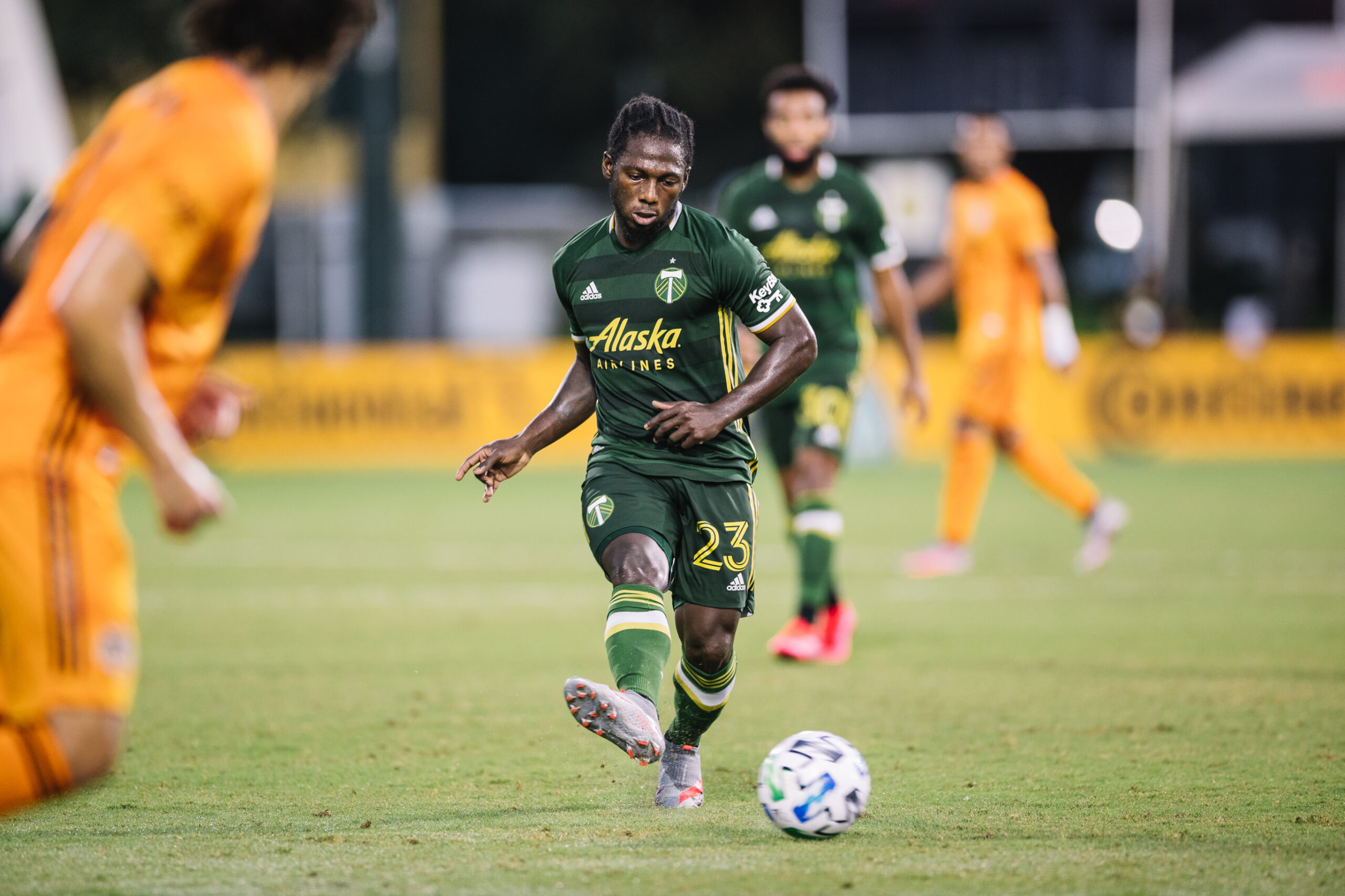
After a slow start to the 2020 Major League Soccer season, the Portland Timbers came to Orlando with something to prove. Although they’ve only played two games in the MLS is Back Tournament, it seems as if they are starting to do just that.
With a pair of 2-1 victories, the Portland Timbers are one of just four teams to take all six points from their first two games. Against the Los Angeles Galaxy, Portland came out sharp and played with a sense of confidence and precision that eluded them against Minnesota United and Nashville SC. They continued that against the Houston Dynamo, playing between lines and controlling possession against one of the most dangerous attacks in MLS.
Through strong and inspired play, the Timbers have guaranteed themselves a spot in the knockout rounds with a game to spare. But just because they know they will advance doesn’t mean they are taking the next game off or will be complacent—at least not with a game against LAFC looming.
“I think there is too much at stake [to be complacent],” head coach Giovanni Savarese told reporters via a Tuesday morning Zoom conference. “First, we want to come away with three points and finish first in the group. We’re not looking at who we’re playing after, that is why the mentality is very strong. We know that it is going to be a competitive match, and they’ve always been competitive games every time that we play LAFC.”
As Savarese mentioned, these two teams have a history in knockout competitions. In the two seasons since LAFC joined MLS, each team has knocked the other out of the US Open Cup in exciting, albeit at times contentious, games. Despite sitting on only four points after two games, an easy argument can be made that LAFC, even sans 2019 league MVP Carlos Vela, is the strongest team in this tournament.
“We have seen in the last two matches that [LAFC] have been challenged,” Savarese said. “I think this is a group that wants to prove to everyone that it is no longer dependent on Vela because many have said that, so maybe that’s one part of LAFC at the moment. We expect a very competitive match, we know that they are very difficult to play against, and we will bring a very good challenge to them like we always have.”
There is Eduard Atuesta and Latif Blessing creating havoc in midfield. Savarese explicitly pointed out the importance of limiting one-on-one opportunities from dynamic wingers Brian Rodríguez and Diego Rossi. At striker, there’s always-potent Bradley Wright-Phillips.
All of this talent available to head coach Bob Bradley is enough to give opposing coaches migraines. Staying focused for all 90 minutes is vital, but it is easier said than done against a team like LAFC.
“I think a major adjustment we need to have is finishing games a little bit stronger,” Eryk Williamson said. “We were up 2-0 both games and conceding late isn’t ideal, but it’s a clear focus point now and knowing us, LAFC’s strength is turning it on late in halves, and I think it’s something where we have to make sure that we are locked in for the 90-plus minutes.
“If we can disrupt them in any way possible and just continue to play our game with the fluidity we have up top and all the interchange to make it really difficult for them to get going.”
In all likelihood, whichever side controls the midfield will most likely win the game. Over its past two contests, Portland has made connecting play through midfield a priority. Managing the midfield means controlling possession, giving LAFC less time on the ball to pick out passes and easily dissect the Timbers’ shape. Emphasizing quick combination play also helps the Timbers create some one-on-one opportunities of their own.
“The combinations that we have practiced have been key,” Yimmi Chará said through a translator. “It is something that we have improved a lot, it’s something that we have been training on for a long time, and taking advantage of that space our opponent gives us. Up until now, it’s been one of the team’s strengths. Now, Gio Savarese wants us spatially to take advantage of those last few feet on the field so we can always take advantage of the one-on-one and come ahead.”
Another benefit of controlling midfield is that it helps shield Portland’s backline, allowing them to focus on defending deeper areas and to not be as concerned about leaving space if they have to help contain Rodríguez and Rossi out wide. If the Timbers can find some success in the midfield, they could prevent counter-attacking opportunities, limit the space LAFC desires, and control the ever-important balance between sending numbers forward in attack versus staying back.
“I know LAFC has a strong midfield and that we want to be known as one of the top midfields in the league,” Williamson said. “I think this is a good test for us as midfielders to win the midfield battle, but not only that, continue to help our backline defend Rossi and Rodríguez. It’s just a very good task for us and we’re excited for the challenge.”
According to Savarese, the Timbers will be playing with a full-strength lineup come Thursday night. He’s reported no injuries to the media, and despite fielding two full-strength lineups over the past week, he doesn’t plan to heavily rotate the lineup in anticipation for the knockout rounds.
Savarese anticipates that Bradley will play his strongest lineup, and once again emphasized the team’s collective goal of taking all three points and winning the group.
Thursday’s game projects to be one of the Timbers’ toughest challenges this season. As the press conference neared its end, Savarese put everything in perspective. The repeating message to the team has been to not take anything for granted, because just two months ago players were locked in their homes. Now, they prepare to take on last seasons Supporters’ Shield winners for the top spot in Group F.
“We enjoy being here, we’re excited to compete, we’re happy to be in a tournament,” Savarese said. “We missed this game when we were at home and now every game for us is a final.”
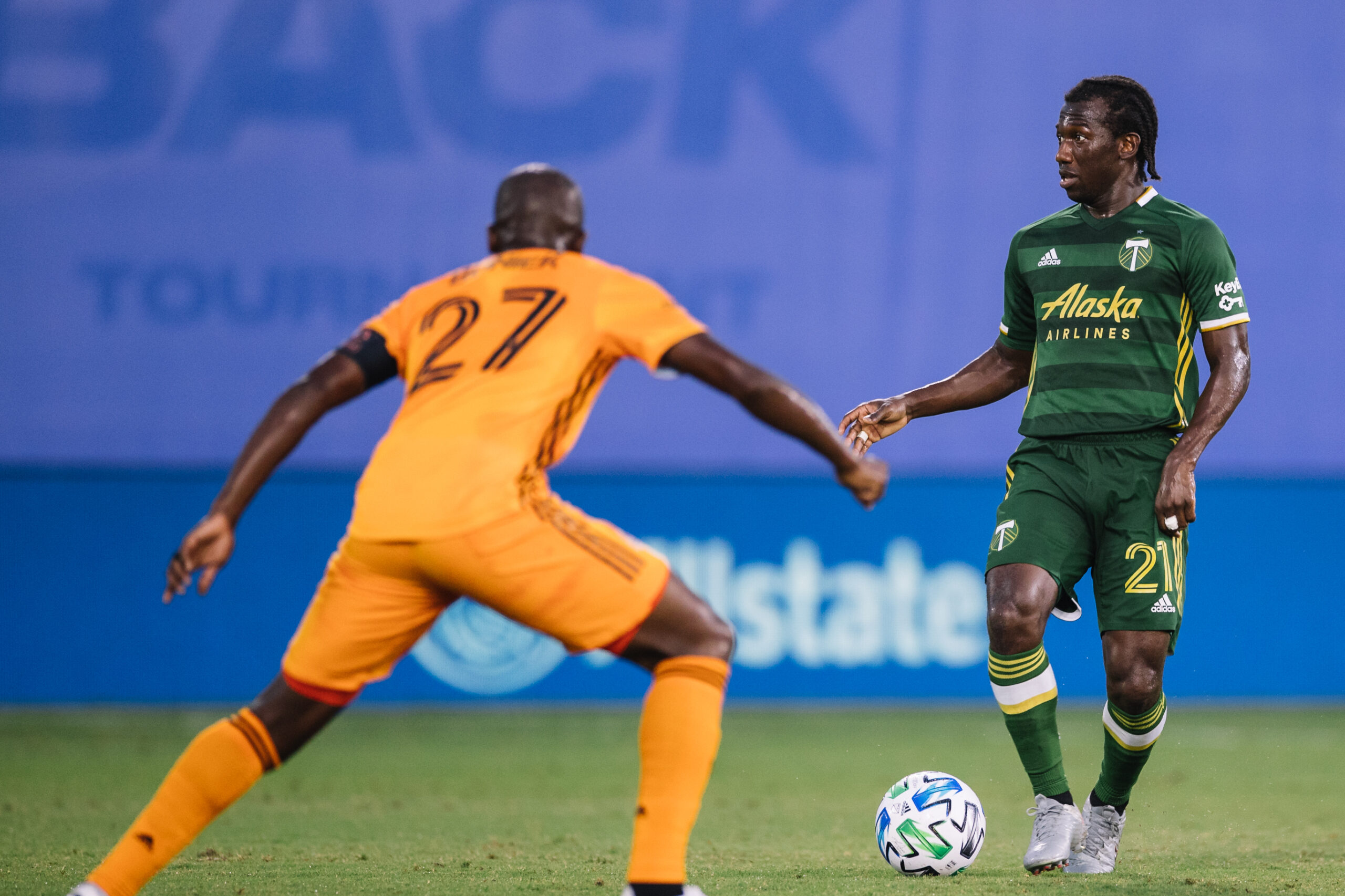
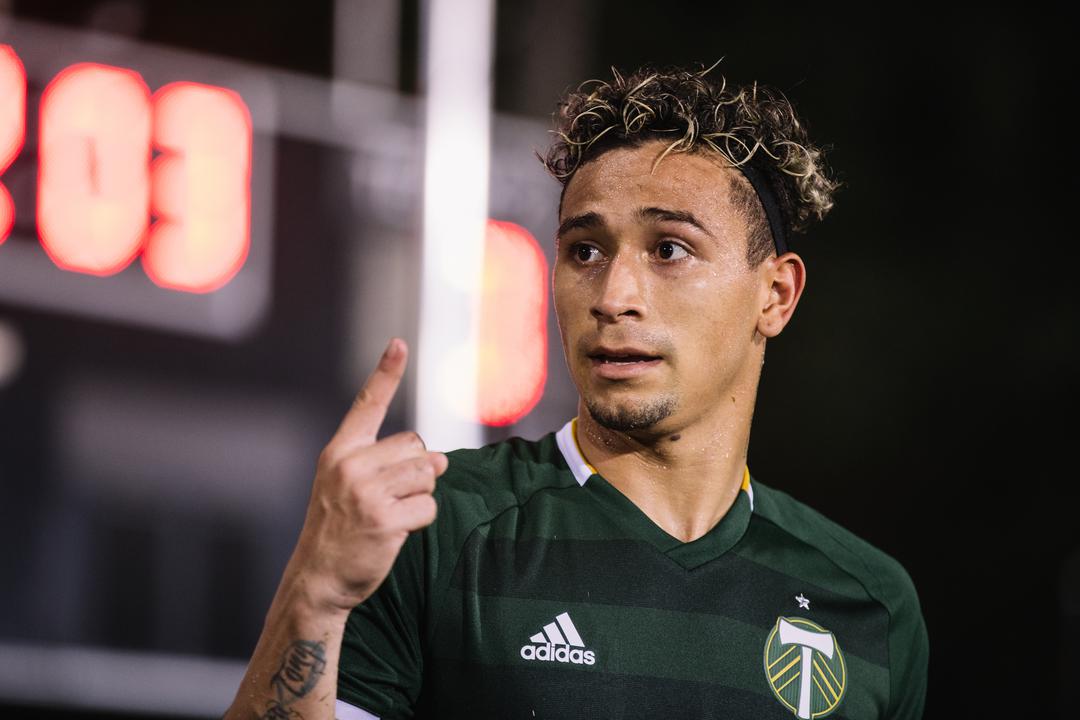
In a battle between two teams looking to outlast their opponent, wear them down, and catch them off balance, the Portland Timbers were the team still standing after 90 grueling minutes against the Houston Dynamo on Saturday night. In their second game of the MLS is Back Tournament group stage, the Timbers looked in control for most of the match as they fought their way to a 2-1 victory.
Although the Dynamo went down a man in the final minutes of the match after Alberth Elis picked up his second yellow card of the night, it was the Timbers’ ability to take their chances that played a deciding role in the match. Inch-perfect finishes from Jeremy Ebobisse in the 35th minute and Diego Valeri in the 61st minute put the Timbers up 2-0, giving the side the breathing room needed to see out the match.
Before his sending off, Elis did manage to pull one back for the Dynamo, earning a penalty kick in the 86th minute after putting a header off the hand of Jorge Villafana — who had an otherwise excellent game — and then stepping up to convert the spot-kick past Steve Clark to pull the Dynamo back within one with minutes left in the match.
In the heat and humidity of the Orlando summer, a major factor in the match against the Dynamo seemed to be the fresh legs of the Timbers’ substitutes.
Giovanni Savarese went to his bench early on Saturday, bringing on Andy Polo for Yimmi Chara in the 60th minute. He then made two more subs in the 69th minute, bringing on Marvin Loria and Jaroslaw Niezgoda for Eryk Williamson and Jeremy Ebobisse. Finally, Savarese capped off the night by bringing on Chris Duvall for Pablo Bonilla in the 82nd minute after the youngster absorbed his third hard foul of the night.
The Dynamo, on the other hand, made one sub in the 62nd minute, one in the 87th, and two in the 88th.
As a result of Savarese’s aggressive use of subs, the Timbers looked markedly fresher than their opponents during the second half even after having played with a man down for a big chunk of last Friday’s win over the LA Galaxy. With the Dynamo flagging, the Timbers subs were able to make a real impact on the match, quickly breaking up Dynamo attempts to get forward and winning the fifty-fifty balls that might otherwise have given Houston a chance to get back in the game.
Despite being subbed off late in the match, Saturday was a successful first-team debut for Bonilla who got the start over Chris Duvall at right-back, being granted the privilege of matching up against the Dynamo’s vaunted attacking trio: Alberth Elis, Darwin Quintero, and Mauro Manotas. Bonilla, a Venezuelan youth international signed from T2 exactly one month ago, was introduced to the MLS life by the Dynamo when in just the 7th minute he took a cleat to the thigh from Houston midfielder Maynor Figueroa.
Despite the rough treatment by the opposition, Bonilla acquitted himself well in the first half, providing solid coverage down the right flank and acting as an outlet for Yimmi Chara on his regular runs forward. In the second half the youngster continued his strong outing, getting further forward down the pitch as well as providing several clutch tackles when the Dynamo got forward on the Timbers’ right.
Most interesting was Bonilla’s play with Marvin Loria after the Costa Rican 23-year-old came on as a substitute early in the second half. After spending the pre-suspension preseason together with T2, Bonilla and Loria had clear chemistry playing together on the wing and combined for a strong chance on goal that Loria ultimately had blocked by a defender as he got his shot away.
The win against the Dynamo guarantees that the Timbers will reach the knockout rounds of the MLSIBT and leaves the Timbers with a final group match against LAFC next Thursday that will at most affect the Timbers’ seed coming out of the group stage.
How the Timbers treat this match will tell us much about how they view this tournament and how they view the possibility of playing out the remainder of the season. These group stage games count as part of the 2020 MLS regular season, so it will be interesting to see if the Timbers view this last group stage match as a chance to get minutes to players that have mostly served as subs like Niezgoda or Andy Polo, to bring in some youngsters like Blake Bodily or Marco Farfan who have yet to see the pitch, or just another game to run out the regular starting XI, tournament be damned.
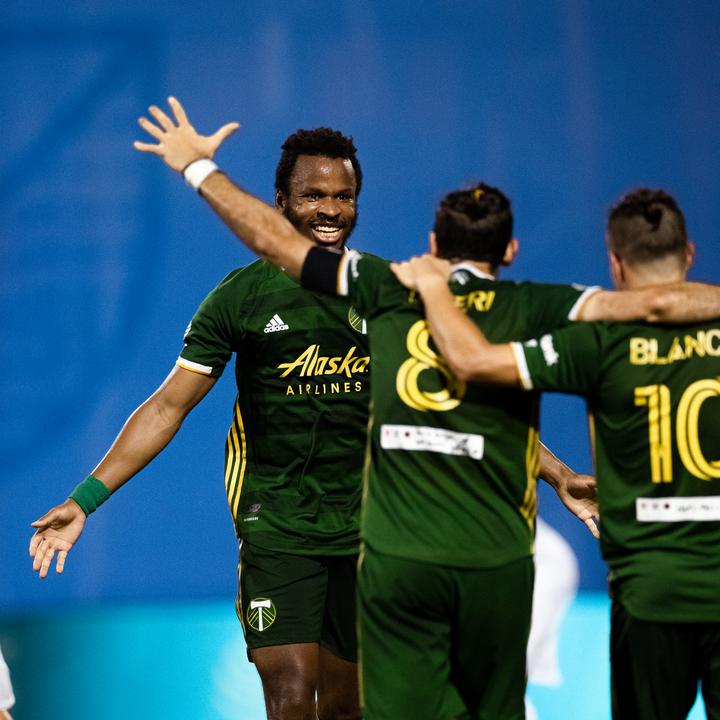
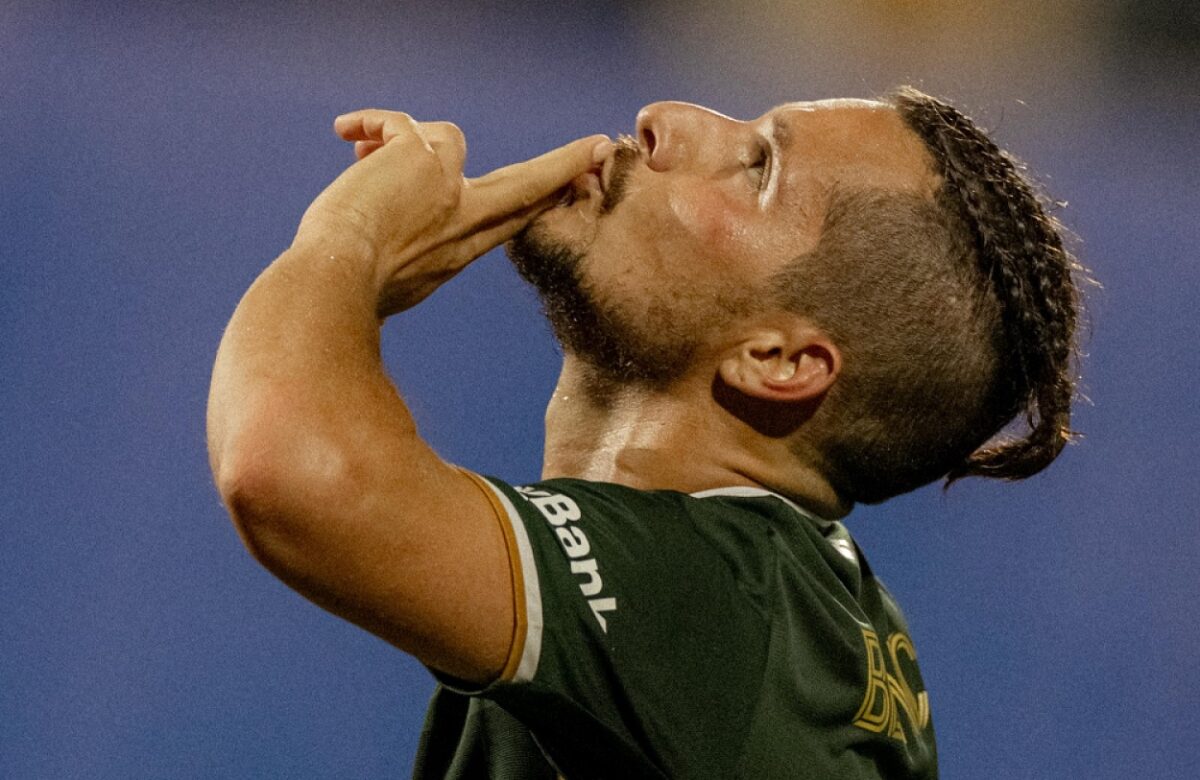
After four months without a match, the Portland Timbers returned to play last night in the MLS is Back Tournament. Before the opening whistle, cameras at the ESPN Wide World of Sports caught Diego Valeri in a smiling conversation with an LA Galaxy player.
Moments later, the Maestro and every other player on the pitch were kneeling in silence.
And moments after that, the whistle blew and the Timbers were once again playing soccer.
Despite a 75th minute red card to center back Dario Župarić, the Timbers were able to snatch all three points in Monday night’s up and down affair against the Galaxy––taking down the Californian side 2-1 in their first action since the suspension of the MLS season back in March. The match itself played out in four phases:
It was that third phase that gave us the most exciting moments to hold on to when the Timbers opened the scoring in the 59th minute and quickly followed that up with a second goal in the 66th.
The first goal was a pure distillation of this Timbers side. Yimmi Chará started the moment with an impressive snap header on goal off a cross that looked over-hit, forcing David Bingham to palm the ball away with a quick reaction save. Then Diego Valeri and Sebastián Blanco combined brilliantly as the Maestro received the ball at the top of the Galaxy box and patiently picked out a long, curving run from Blanco in behind the Galaxy back line. And, finally, Blanco was able to turn on the ball and pick out Jeremy Ebobisse in front of goal, threading a pass through a handful of defenders for Ebobisse to knock home despite a defender firmly attached to his back.
The second goal was simply down to the sheer cussedness of Blanco. After a shot from Ebobisse was deflected off his foot and sent looping away from goal, it seemed certain that the Timbers attack was broken and the Galaxy would have a chance to clear. As the ball fell back to earth out on the wing, however, Blanco refused to let it die. Rushing forward, he got a head to the ball, catching a defender unaware and skillfully touching it toward goal where another Galaxy defender was waiting to make the tackle. Instead, Blanco was able to somehow push the ball through that second defender and into space in front of the Galaxy goal where he wrapped up the move by hamming home a shot from close range that left Bingham waving hopelessly at the ball as it flew by.
While Blanco and the Timbers attack grabbed the win for the side, the defense nearly gave the game away on two occasions before clamping down and securing the three points for the side.
In the 11th minute, on one of the first attacking moves from the Galaxy as they tried to escape a protracted period of possession from the Timbers, a deflected ball fell to Cristian Pavón twenty yards from goal. Approaching the top of the box, the Galaxy No. 10 let loose a shot that flew directly into the torso of Župarić, clattering off his arms and immediately drawing a whistle and a yellow card from referee Ramy Touchan.
Chicharito Hernández stepped up to the spot and, with Timbers hearts sinking, struck his attempt on goal. Steve Clark, however, had other ideas and, reading the Mexican international legend’s run up, dove the correct direction and stopped his shot. Then, scrambling, Clark did the splits to stop the follow-up from Sacha Kljestan before diving on the ball to end the Galaxy hopes of an easy opener.
Although he was bailed out by Clark, that yellow card would come back to haunt Župarić in the 75th minute when he took down Pavón just outside the Timbers box, prompting an easy second yellow from Touchan and leaving the Timbers down a man for the rest of the game.
While the Galaxy would eventually find the back of the net in the 88th minute when Chicharito momentarily showed off some of the predatory instincts that made him such an effective player throughout his career, they were stymied time after time by the Timbers backline stepping up for an offside trap or swarming the ball to take advantage of a loose touch, or simply knocking away cross after cross that the Galaxy sent hopefully into the box.
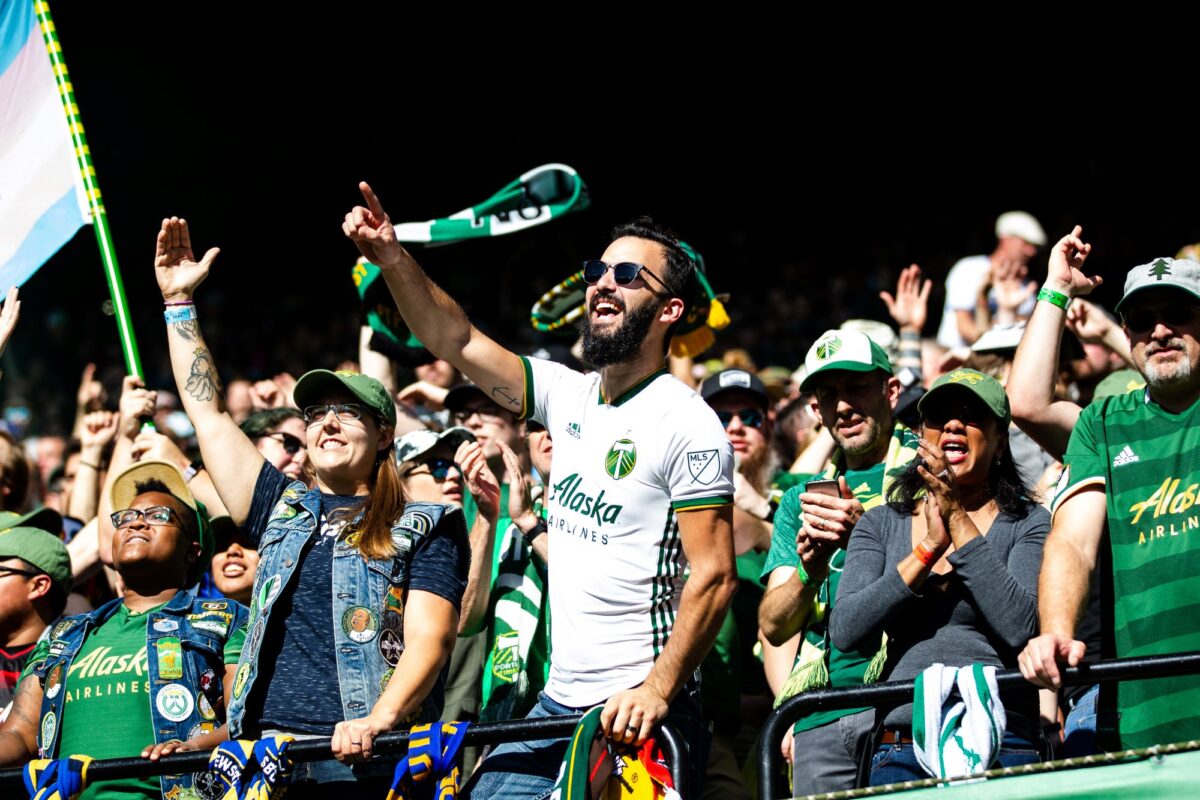
Disclosure: Jennifer Ingraham, a 107ist board member, also serves as a copy editor for Rose City Review. She was not involved in the creation of this piece in any way.
On June 1, Milo Reed published a post on Medium, detailing his experiences as a Black capo in the Timbers Army and member of the 107 Independent Supporters Trust—the nonprofit organization that coordinates both the TA and the Rose City Riveters.
Reed describes an instance from 2018, in which the 107IST Board of Directors deleted a blog post that they, a group of non-Black people, deemed to be offensive to the Black community. However, Reed, “felt that the post was not problematic & urged the 107ist board to consult communities of color before speaking for them.” He also requested the Board share a copy of his email; Reed points out that, a couple of months later, a white capo was allowed to share their own thoughts about race “on the same website [Reed] was denied access to.”
According to Reed’s post, the Board asked him to explain his requests to them at their next meeting, less than 48 hours in advance. Based on the context of the invitation, Reed believed it to be “disingenuous” and “like [the meeting] was going to be an interrogation as opposed to a conversation.”
“I can’t count the number of times I have brought a plan, concern, or proposal to a 107ist board member only to be given a metaphorical pat on the head, a terse rejection or worst of all ignored,” writes Reed. “This has only intensified in the last couple of months. I have told several people they have behaved in ways that were disrespectful & patronizing since March, only to be told ‘I’m sorry you feel that way.'”
Three days after Reed published his story, the 107IST Board shared a response, acknowledging their failure to listen to BIPOC voices in the TA and RCR—although doing so without explicitly mentioning Reed or his own blog—and declaring a commitment to publicize a detailed anti-racism plan within the next 30 days.
Reed’s post came in the wake of the murder of George Floyd, in the midst of global protests against police brutality and systemic racism and calls that Black lives matter. (“If Black Lives Matter what about Black voices?” Reed asks.)
The outcry—and wave of public statements from their Black members—has pressured many organizations to examine the role of race within the spaces they inhabit.
When examining the role of racism within these spaces, it’s important to first acknowledge that we live in a society that’s systems of power and organization were created by white people who often strove to exclude people of color. Whether through the institution of slavery, segregationist policy, or simply hostile attitudes that targeted BIPOC, they conveyed that people of color were not welcome.
Although many of these laws have been repealed, these spaces cannot be separated from their racist origins. When those in charge do not attempt to reconcile with and actively combat this racist past, those same systems of inequity remain unchecked. We see them perpetuated in the racial wage gap, in the small number of people of color—especially Black and Indigenous people, especially Black and Indigenous women—that hold leadership positions in companies, in the over-policing and mass incarceration of BIPOC, and in countless other areas of everyday life. As Simone Charley points out, these “power structures [are] so ingrained in society that to question them is to question yourself.”
Like many organizations across the United States, the TA and the 107IST are a product of the society that they belong to. Regardless of self-proclaimed anti-racism and anti-fascism, members not immune to intrinsic bias; Reed’s story shows as much. And, as tends to be the case with systemic racism, his experience is not an isolated occurrence.
“When I first moved to Portland in 2016, I didn’t know a single person there,” says Chelsea Waddell, a member of the 107IST, “definitely not anyone in the soccer community.” She recalls going to the 107IST website and reading about the group. Something stuck out to her on the 107IST’s “About Us” page: “We have always said that if you want to be Timbers Army then you already are […] Since 2013, the same has been true for the Rose City Riveters.”
“I was like, wow, what a cool sentiment,” Waddell says. “You don’t have to be anyone special or do anything to be part of this organization.
“I think you’re immediately accepted when you walk into that group,” she continues. “There’s no prior judgment of who you are because of who you are. If you’re a member of the LGBTQ+ community, which I am, and a person of color and a woman—I’m really hitting the triple threat there—you can walk in and really be embraced, but I feel like only if you agree with everybody else all the way through.”
Anabel Ramirez, who was a regular presence in the North End for roughly ten years, feels similarly about her experience in the TA. “I got hooked into it,” she says. “It felt like a cult fervor when you first join in, and you want everything: you want all the scarves, you want all the patches, you know all the chants. You get really clicked into this idea that it is a collective, and then it doesn’t feel so collective in certain aspects.”
Both Ramirez and Waddell believe that this sense of collectiveness is enforced by the unspoken expectations in the TA, and, to a lesser extent, the Riveters: standing and chanting together, cheering on the team, and staying off your phone. For those involved outside of games, it’s volunteering your time and money, helping in the creation of tifos, and contributing to 107IST fundraisers for other nonprofits around Portland.
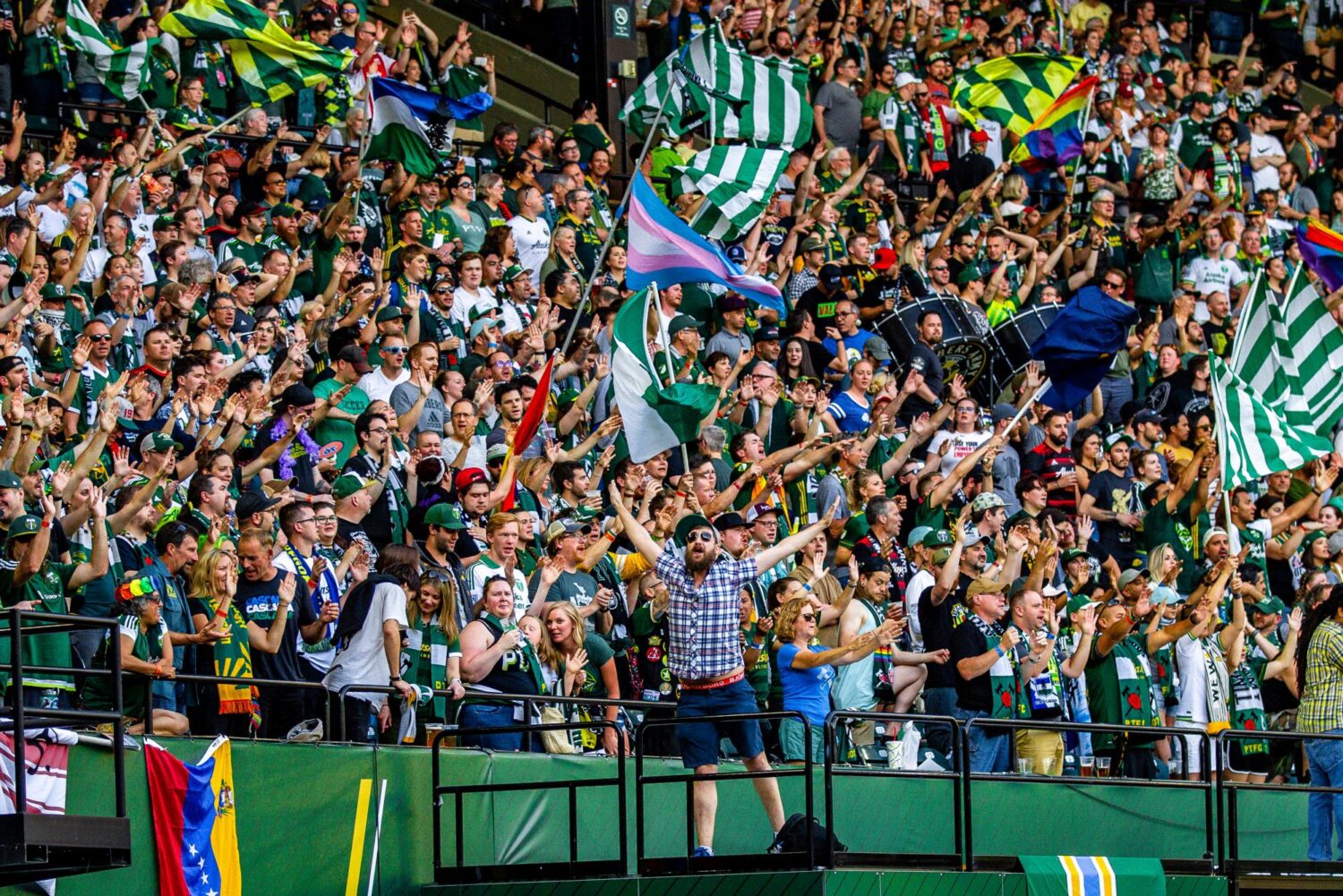
However, unspoken rules can lead those who are unaware of them, or simply wish to express their support in a different way, to feel as if they don’t belong. This is only accentuated for BIPOC fans who are already navigating a very white space.
“In trying to be this cohesive North End voice, they stamp out a lot of other voices,” Ramirez observes. “I don’t think a lot of them see themselves as stamping out specifically Black and Brown and Asian voices, but it happens.”
Ramirez points to the fact that many of her BIPOC friends don’t feel welcome in the TA—from those who simply don’t want to acknowledge the group after they displayed the Sunshine Flag, to the large numbers of Latinx families who show up at Timbers 2 matches, but not Timbers games. She, herself, felt uncomfortable in the TA unless she was with a certain group of friends.
As a Black woman, Waddell perceives the racial diversity of the TA and RCR to be similar to that of Portland, a city that is known for being very white.
To Jake Payne and Phil Bridges, this problem isn’t exclusive to Portland. The two are co-founders of Black Fires, a Black supporters group for both the Chicago Fire and the Chicago Red Stars. “You see this with a lot of supporters groups around the league,” Payne points out, “of saying that you’re inclusive and diverse, but your stands don’t really reflect that. I think that’s something that more than Section 8 or Timbers Army or anyone need to look at […] like, okay, if we’re that inclusive, why don’t our stands reflect what our values are?”
Bridges points to the fact that, in Chicago, it took over 20 years for a real push to make the stands more diverse—both in terms of LGBT and BIPOC fans—to actually happen. “You have just a lot of people who love the idea of saying that they’re diverse,” he says. “They love the idea of that, they seem open, they love talking about it, they love feeling that way, but when it comes to actually putting in the work to make sure that happens, it’s totally different.”
One of the factors is how a club markets itself. “There is the reality of soccer’s not as big as it should be in the Black community in the United States,” Payne acknowledges. On the other hand, he notes that Chicago’s clubs weren’t actively trying to engage with the Black community until Black Fires called on them to do so.
“It’s really liberating to be able to make the experience what you’ve always wanted it to be,” says Payne, “but it’s also very frustrating, because you have to constantly almost drag people to care about this in a genuine way.”
Before the COVID-19 pandemic, one of the ways Black Fires was working to reach prospective fans was through watching games with them. Payne explains that the majority of the bars that Fire supporters frequent are in the north side of the city, which is more white. “What’s a bar [where] we can watch in the south side?” he asks. “What’s a bar where we can watch that’s Black-owned or in a Black neighborhood, so that we can be more present?”
Payne thinks this engagement is an important step beyond a trap that many fall into—fans or otherwise. Too often, he points out, “donating takes the place of actually reaching out to communities that need it and making a connection.”
Both Ramirez and Waddell notice this within the TA and RCR. “I don’t feel like they are actively fighting for people of color,” Waddell says. “I think they are passively allowing them to be a part of it, and openly embracing different people, but never going any deeper than that.”
As an example, she and Ramirez point to the 107IST’s donation drives for other nonprofits in Portland.
“I do think that the organization can be a little bit show-y, white savior-y, performative,” acknowledges Waddell. “In football culture, being antifascist and fighting for marginalized people is really, really cool, but I feel like we do it just because it’s cool […] There’s just not a lot of substance there.
“It doesn’t really matter if you can fly a certain flag or wear or display a certain symbol if you’re not doing other things to support that fight. It’s just a symbol.”
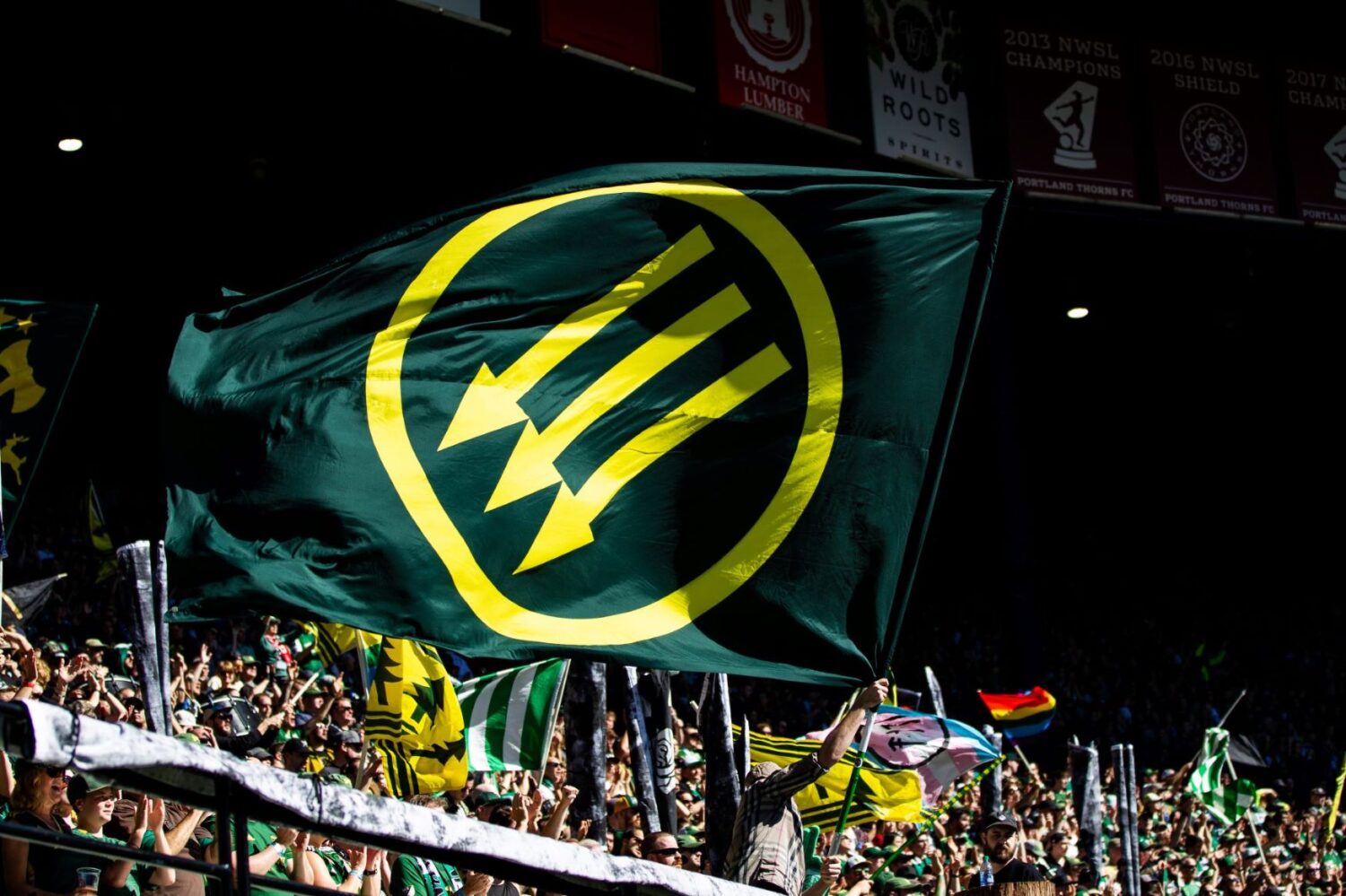
In her time with the 107IST Outreach Committee, Ramirez notes that the group would donate to organizations without making any effort to engage with the communities that those organizations represented. She explains that this was one of the main reasons she ended up leaving the committee. At the time, Ramirez said as much to the 107IST, but didn’t feel like anyone was paying attention.
“I feel like every time I would go and try to make a suggestion of some sort—it was either because I was female or because I was Latina or probably the combo—that I wasn’t getting listened to,” she says.
For Waddell, this failure to listen to BIPOC voices became evident during the discourse around the Iron Front last summer. “Obviously, this was a really passion-driven discussion, but from where I sit, part of that fight was to ‘protect’ me,” she says. “I feel like there was no space given to the people that people were fighting for.
“I just, as a person of color, didn’t see how displaying a symbol would change anything for me,” Waddell explains. “I think that’s kind of the discussion we’re at this summer, on a bigger scale, is that it’s not displaying a symbol that makes people feel safer; it’s action and words and listening to them.” While she wanted to express this at the time, she was afraid of the backlash she would face for presenting an opinion that differed from the group’s.
That fear of retaliation was validated by Reed’s post, by his stories of trying to speak up and the resistance he faced. “It was brave of him to even try,” Waddell says, “and still no one listened.”
When Reed was offered an opportunity to communicate with the 107IST Board, it was on short notice and in a space of the Board’s own creation. “[It’s] like, ‘yeah, we will listen to you,'” describes Payne, “‘but only in these predefined structures that we feel work, this is how we’ll listen to you.'”
Payne acknowledges that a refusal to listen to BIPOC voices unless they’re speaking in white-created spaces is a systemic issue: “I think that’s how a lot of places operate, not just in soccer, and it’s just not right.”
To Payne, now is a perfect time to examine the ways in which any organization perpetuates systemic racial inequity—intentionally or not. “[The] Timbers Army is just in the spotlight because they had the most public thing about it,” he says. “Plenty of other groups operate like this right now, and I think this is a good time—with it being a ‘break in society,’ with not many supporter initiatives happening—for any group, NWSL, MLS, USL, to really be thinking about, ‘okay, how are we operating?’ Especially the older groups, like Timbers Army or like Section 8: ‘this is how we’ve been operating, but is it the right way to operate?’ I think that really needs to be a big question going forward.”
“We are […] evaluating the different committees within the organization, looking to create more transparency and points of entry,” says Gabby Rosas, the newly-appointed president of the 107IST Board.
In the follow-up report from the 107IST, she shared the Board’s plan to reevaluate different areas of their operations. These include a BIPOC committee, a list of the specific places the Board is hoping to address, a summary of the outside groups the Board has formed partnerships with, and a handful of suggested books, podcasts, and movies.
“Personally, I have been reflecting on my own pathways into the organization, my own decision to run for the board, and advantages I’ve had as a white-passing person in Portland,” says Rosas, when asked about the work she’s done to examine the role of whiteness in the 107IST. “This is a large organization with many people who care passionately about the Timbers, the Thorns, supporter culture, and the community. It can be very intimidating, and I have not done a good job of recruiting and sustaining their participation, I should have been more extroverted when it comes to getting others involved in all aspects of what this organization does.”
She points to the barriers of entry that exist within the organization focusing on the time commitment asked of those involved. “There are many barriers to entry and advancement, from the supporter group involvement to the board election,” she explains. “I have been and will continue to identify barriers and address them.”
For Waddell, the hours asked of the BIPOC team was a major reason she didn’t join when invited. “I don’t really have time to volunteer to teach this Board how to just listen to people of color,” she says. “And I think there’s a lot more going on within the organization that they need to do to support people of color, but […] there’s no class you need to take or book you need to read or podcast you need to listen to to understand how to just listen to someone when they speak.”
The other factor was money. The BIPOC committee, like other 107IST committees and Board positions, is run by volunteer work. However, Waddell currently does diversity, equity, and inclusion work for her job, and felt it wasn’t worth taking on additional emotional labor—especially, for free.

The BIPOC team shares that they now have 20 members on board, 10 of whom are currently actively involved. According to the 107IST update post, the committee has met twice so far. They “plan on meeting again soon while we work on our mission statement and other tasks that include the board.”
When asked about how the member-led BIPOC committee will remain impartial in their evaluation of the 107IST, Rosas says: “Everyone’s experience with this organization is valuable, be it positive or negative, or if they are a member or non-member. We are also not opposed to working with other local groups for guidance and insight as this committee is formed.”
The committee is not following a specified timeline, but Rosas explains that the Board isn’t planning to sit around and wait. “The hope is that as we work to remove barriers for entry and highlight different pathways in our organization, we can do so in such a way that will address the needs of marginalized groups,” she says. “As we work on change, we will be doing so at a pace where we can check in with our community, including the BIPOC team, and local organizations that have offered their support. Our goal is to be able to incorporate the feedback and tasks from the BIPOC team as they want to provide it.”
One of the ways Rosas hopes to do this is by increasing the accessibility of Board meetings. “We have never had the attendance at another board meeting like we did the June meeting,” she shares, a meeting that happened virtually to accommodate for the COVID-19 pandemic. In response, the 107IST is moving their monthly meetings to online, accessible spaces. Rosas points specifically to Google Meet, which offers closed-captioning.
As another area of focus, she hopes to more actively work with local organizations that serve BIPOC communities and other marginalized groups. “If we can increase our engagement, both through volunteering and by inviting them to 107ist events, we will hopefully be able to improve the accessibility to joining the Rose City Riveters, Timbers Army, and 107ist,” she says.
To open up space for BIPOC voices, former 107IST Board member Ray Terrill stepped down from his position and asked that his spot to be filled by a person of color. Sherrilynn “Sheba” Rawson also resigned her presidency to Rosas, although Rawson remains on the Board.
For Ramirez, those changes aren’t good enough. “Until there are at least three seats on the board filled by BIPOC, I don’t think they can move forward on this,” she says.
Rosas believes that we’ll see that shift later in the year. She explains that, as advised by Western States Center’s Eric Ward, many members have chosen “to not resign but to work on the changes until BIPOC appointments can be made or elected.”
Come Board elections in November and December, Rosas thinks the leadership changes will materialize. “I imagine that a number of board members will either choose to not re-run or step down at that time,” she says. “We will actively work with the BIPOC team should individuals want to join the board. We not only want BIPOC members on the board but also on all of the committees throughout the organization.”
Key to this will be accountability; the 107IST will have to prove that they’re seeking out and paying attention to BIPOC voices going forward. “I think a major way to prove the 107ist board is actually listening is to make changes based on what is heard and then to keep checking in to see if the changes have had an impact,” says Rosas. “I expect that many aspects of the change that is needed will not be one and done.”
Whether or not those changes play out in meaningful ways remains to be seen. However, BIPOC fans speaking up now hope that, this time, listening to their stories is a first step.
“I really love this organization,” says Waddell. “I love the team, every single player, everybody who’s at the games, everybody who’s watching from home. It means a lot to me, and that’s why I do want to speak about it. It’s not out of hate, it’s out of we can do better, and we need to do better, and we have the passion to be better […] I really do love this organization and these groups, and everything I’m saying is out of the understanding that we can be better. We have to.”